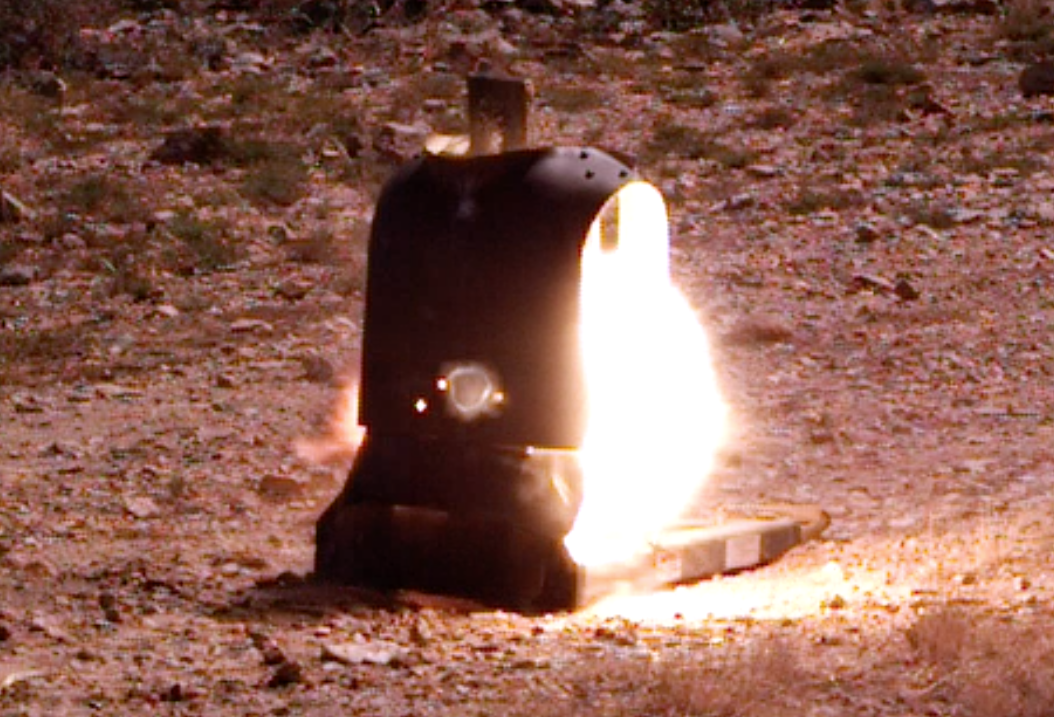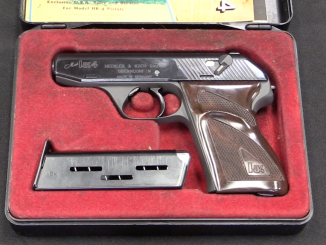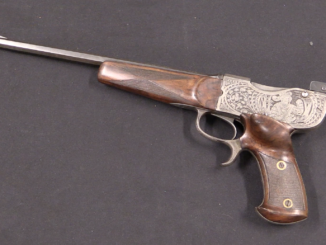The Sd.Kfz. 2 Kettenkraftrad (aka Kettenrad) is a deliciously German sort of vehicle, a small utility tractor made with a pair of treads and motorcycle front wheel. It was powered by a 4 cylinder Opel automotive engine generating 36 horsepower, and had a 3-speed gearbox with high and low range transfer case. Top speed was 44 mph, and it could tow about 1,000 pounds of ammunition or other supplies in a small 2-wheeled trailer, or directly tow light artillery pieces.
The vehicle was developed in 1939, and in mass production in time to see substantial use in Operation Barbarossa; the German invasion of Russia. Although complex to maintain and expensive to produce, the Kettenkrad was quite well suited to the terrain and distances of the Eastern Front. As the war progressed and supplies became scarcer and artillery became heavier it was less universally useful, but remained in service until the very end of the war, tasked with jobs as mundane as towing aircraft at airfields. After the war, they were put into civilian agricultural service (much like the Jeep in the US).
This example is in the rental fleet at DriveTanks.com, available for instruction and driving to anyone. It is one of my very favorite vehicles form World War Two, and I really appreciate DriveTanks giving me the opportunity to do some driving on it and show it to you!




FYI: Sd.Kfz. = Sonderkraftfarhzeug = “special purpose vehicle,” essentially an inventory number. When German authorities decided to supersede the word “tank” they chose the (also typical) multi-syllabic “Panzerkampfwagen” (= “armored fighting vehicle”). Each Pz.Kpfw. Mark also had an Sd.Kfz. number for requisite complication. Thanks for this fun posting.
The running gear assembly is a mechanical nightmare for any person replacing a broken wheel. You’ll need to disassemble the entire thing!
“(…)running gear assembly(…)”
Whatever you praise or curse that, direct it at ingénieur Kniepkamp
https://fr.wikipedia.org/wiki/Heinrich_Ernst_Kniepkamp
I disagree with the implied comment that this is not a weapon! It might have not been armed or armored, but, it did it’s part during the war. Just like the DC3 or Liberty ships, or even the uniforms used during any war, it was a weapon to be used for the “cause.” I’m glad you made this video, I have been interested in this vehicle for years.
If you need armed (and armoured) vehicle similar in size to Kettenkrad, see: https://tanks-encyclopedia.com/ww2-sweden-landsverk-armored-motorcycles/
In “fantasy land WWII” this thing would have a quad-Panzerfaust or 20mm cannon on the stern with a gunner in a 360 degree mount.
Another use for the Kettenkraftrad was as an airborne gun towing vehicle. The Fallschirmjager used it as a glider-delivered vehicle towing the 10.5cm LG/40 recoilless gun, to cite just one example.
As for its use as an aircraft towing tractor, it had less to do with fuel conservation than engine wear and airfield safety. Taxiing planes around under their own power tends to overheat the engines, even on liquid-cooled inlines. This causes excessive engine wear, that is best avoided by using tow tractors. Such tractors were used at almost all USAAF and RAF fields throughout the war, and are still used today.
There’s also the effects of propeller backwash on the surroundings to consider. You’d be amazed what kind of damage the prop blast of a Daimler-Benz DB 601 can do when it hits something like a building. Those signs around the apron saying BEWARE OF PROP BLAST were not meant for laughs; they were warning of serious danger to equipment and especially personnel.
This was especially true of the Me262 and Ar234 jets; you really didn’t want those things taxiing any distance under their own power, due to the backblast of the jet engines.
Also, the K-rad was used as a tow tractor at Me163 Komet fields because the rocket-powered Komet interceptor simply couldn’t taxi under its own power, period.
The Luftwaffe didn’t actually have a specifically-built aircraft tow tractor during the war, unlike the USAAF and RAF. Fortunately for them, the little Kettenkraftrad was up to the job.
cheers
eon
And yet I have to ask the obvious question: Why didn’t similar vehicles get produced after 1945?! Oh, wait, because the occupying powers saw no need to reintroduce a now redundant vehicle once they brought proper airport tractors and blueprints for such into Germany. To make it more insulting, the imported designs were likely cheaper to produce and maintain (no need to rip the entire running gear assembly and chassis apart just to replace a single wheel). I could be wrong.
Also, consider how many such vehicles there already were available, because they were no longer needed for jobs like towing bombers around at bases in England.
As a WW2 USAAF Col. I knew said, in 1945 Europe got the free gift of literally thousands of pieces of airfield equipment ranging from tow tractors to fuel trucks and even entire machine shops from the USAAF, simply because it would have cost too much to ship them back across the Atlantic.
Whatever else WW2 did in Europe, it certainly jump-started its commercial aviation industry. Not least because of all the infrastructure left behind that was not just for light aircraft as it had been before the war, but for heavy four-engined bombers.
Which is exactly the kind of infrastructure you need for airliners.
cheers
eon
“(…)Why didn’t similar vehicles get produced after 1945?!(…)”
But is not aerodrome surface, which is already paved or otherwise make flat enough for starting/landing, place where wheeled vehicles satisfactory?
BTW were not never (post-1945) aeroplanes requiring paved runaways?
Actually there was at least one post war equivalent
In Italy
I can’t remember its name, but it had simplified tracks and a single front motorbike style wheel for steering. The front wheel may even have been driven.
The V twin engine was further developed and became the classic power unit for Moto Guzzi bikes
@Slow Joe’s comment further down got there first and with more info about the Moto Guzzi vehicle.
After seeing this and a tracked submarine, I’m convinced the Germans would have put tracks on a toothbrush if they’d been given half the chance.
Not only they were toying with idea of combining motorcycle and tracked, see 3rd image from top: https://historygarage.com/strange-or-visionary-tracked-motorcycles-of-the-past/
it was tested by French Army.
As long as you’re doing oddball vehicles, give this a look-see:
https://en.wikipedia.org/wiki/Vespa_150_TAP
It was an interesting concept. One or two might have survived in museums. This is right up Ian’s alley because it’s French! He’s already reviewed the 75mm recoilless rifle. Vespas are still popular–I think. It’s been a while since I was in Europe last.
Like the Kettenkrad, this was a real vehicle fielded by a military organization for specific purposes. And the recoilless rifle carrier was half the team–there was a companion Vespa with more ammuntion.
Regarding air-droppable vehicles see also FN AS 24
https://barnfinds.com/1960-fn-as-24-paratrooper-trike/
it was 4-seater, if you do not believe me see 1st photo from top:
https://www.reddit.com/r/MilitaryPorn/comments/8ws6wj/belgian_paras_ride_in_a_fn_as_24_tricycle_during/
“(…)the recoilless rifle carrier was half the team–there was a companion Vespa with more ammuntion.(…)”
This sound similar to Danish NIMBUS motorcycle armed with 20 mm MADSEN auto-cannon:
http://www.armyvehicles.dk/nimbusmc_20mmmg.htm
which also operated in pairs of gun-carrier and ammo-carrier
I predict a new, never-to-be-defeated, champion in the “Oh Bugger, The Tank is On Fire” test.
If I remember correctly a French manufacturer rebuilt these after the war, removed the wheel, and sold them as agricultural tractors. I believe a similar but less successful effort was made with PZKFW I and IIs
There was a cottage industry of converting war leftovers into more useful agricultural tractors.
Probably the most famous success story from that industry was Lamborghini
His main business was agricultural tractors, especially crawlers. There was even a kit available that allowed wheels with pneumatic tyres to be attached to the sprockets and a free castering front pneumatic tyre, which allowed a steel tracked crawler to be quickly converted to legally travel on a tar road.
Lamborghini’s supercars were a result of his disappointed with a Ferrari
The clutch kept going in his ferrari, so he experimented with having his own guys replace it with a tractor clutch.
The tractor clutch was a success, and Lamborghini famously trolled the notoriously hot tempered Enzo Ferrari about his fix
Ferrari took the bait
Lamborghini then had his guys copy the (basically sound) bottom end of a Ferrari V12 and make twin cam heads based on the excellent Alfa Romeo twin cam heads. Which put him ahead of Ferrari in the field of supercar engines.
Lamborghini was not alone among tractor makers in going into the hot car business. The DB in Aston Martin car models, stands for David Brown, one time owner of Aston Martin, and a maker of agricultural (and airfield) tractors and industrial gears.
There is article about Sd.Kfz.2 in tanks-ecnyclopedia
https://tanks-encyclopedia.com/ww2/nazi_germany/kettenkrad_sdkfz2.php
All Girls’ Last Tour manga and anime fans exclaim, “Thank you very much!”
I had planned to write a comment with a Girl’s Last Tour reference, but you beat me to it.
A good fit for forgotten weapons fans, given the use of a type 38 Arisaka by one of the main characters, and the various other weapons shown in the early episodes (Tokarev pistol, M1919 and M2 machine guns, mini-gun etc.)
In fact what got me to watch it was a short clip on Youtube showing the scene where Yu plinks empty cans with her type 38, while Chi spots for her with a Zf-4 rifle scope.
First time I ever heard of halftrack motocycle! How is this not more popular, games, movies ? Truly a forgotten gem.
“(…)movies(…)”
Appears in End of “Saturn” http://www.imfdb.org/wiki/End_of_%22Saturn%22_(Konets_%22Saturna%22),_The
One of them appears in the movie “Saving Private Ryan”.
“(…)halftrack motocycle(…)”
Germans created half-track in many sizes, though not all went into production. For Jeep-sized halftrack see D II 2
https://tanks-encyclopedia.com/ww2/germany/demag-d-ii-liliput
I agree with Ian: this is really smart vehicle which filled tasks otherwise hard to do. I am just thinking about ammo and food delivery, right to the front troops, in addition what was said. I do not know who from belligerents had anything even remotely similar.
“(…)who from belligerents had anything even remotely similar.(…)”
ALLIES counter-parts:
U.S.A.:
– attribute-wise (half-track, towing) M7 Snow Tractor https://en.wikipedia.org/wiki/M7_Snow_Tractor
– size- and weight-wise M29 Weasel https://tanks-encyclopedia.com/ww2/US/cargo-carrier-m29-weasel which was fully tracked
“(…)thinking about ammo(…)delivery(…)who from belligerents had anything even remotely similar(…)”
France used Renault UE: https://tanks-encyclopedia.com/ww2/france/Renault_UE.php
it was fully tracked and unarmed (in basic version) and armoured, was used for tactical supply
It may have been at least partly inspired by the British Carden-Loyd Mark V;
https://i.ytimg.com/vi/v_xsOXEMESA/hqdefault.jpg
Or the Morris-Martell tankette;
https://www.tanks-encyclopedia.com/wp-content/uploads/2016/11/morris-martell-tankette-rear-wheel.jpg
Both were developed in Britain between the wars, mainly as “colonial” vehicles.
The Carden-Loyd was basically a three-wheeled motorcycle with a set of auxiliary tracks for rough going, that could mount a single Vickers-Maxim HMG. It was usually shown without a “turret” on top.
The Kettenkraftrad could be seen as a Carden-Loyd minus the rear wheels.
cheers
eon
How about the good ol’ Bren gun carrier? Sort of similar…maybe
The Bren Carrier and later Universal Carrier were all basically developed from the Carden-Loyd and similar British “tankettes” of the 1920s and 1930s;
https://en.wikipedia.org/wiki/Carden_Loyd_tankette
cheers
eon
“similar”
British Universal Carriers were similar in that as Kettenkrad offered motorcycle-like steering, they offered automobile-like steering with vertically placed steering wheel – might be seen when looking from top for example on following photo: https://en.wikipedia.org/wiki/File:Universal_Carrier_Mk_II_pic-10.JPG
thus providing method of driving already to known to people which had experience with motorcycles/automobiles respectively, which I presume were more common in III Reich/Commonwealth population respectively than experience of operating fully tracked levers-commanded vehicles.
The Kettenkrad is an evolutionary dead end since small 4×4 vehicles like the Jeep, or the Puch Haflinger did the same job at lower cost and complexity. The only comparable post war vehicle was the Moto Guzzi Autoveicolo da Montagna which was a 3×3 trike with optional tracks powered by a detuned 750 cc motorcycle engine.
In russian bogs and rasputitza I think this vehicle stands better chance.
Also, there are aftermarket track kits for several ATVs. Snowmobiles of course are full-time “halftracks”.
Such a chassis layout is not suitable for the mud.
If today is dirt and frost at night, tomorrow you will not go anywhere before lunch.
Somebody put a BAR gunner in the back seat. Must be a TIGER down the road……………..